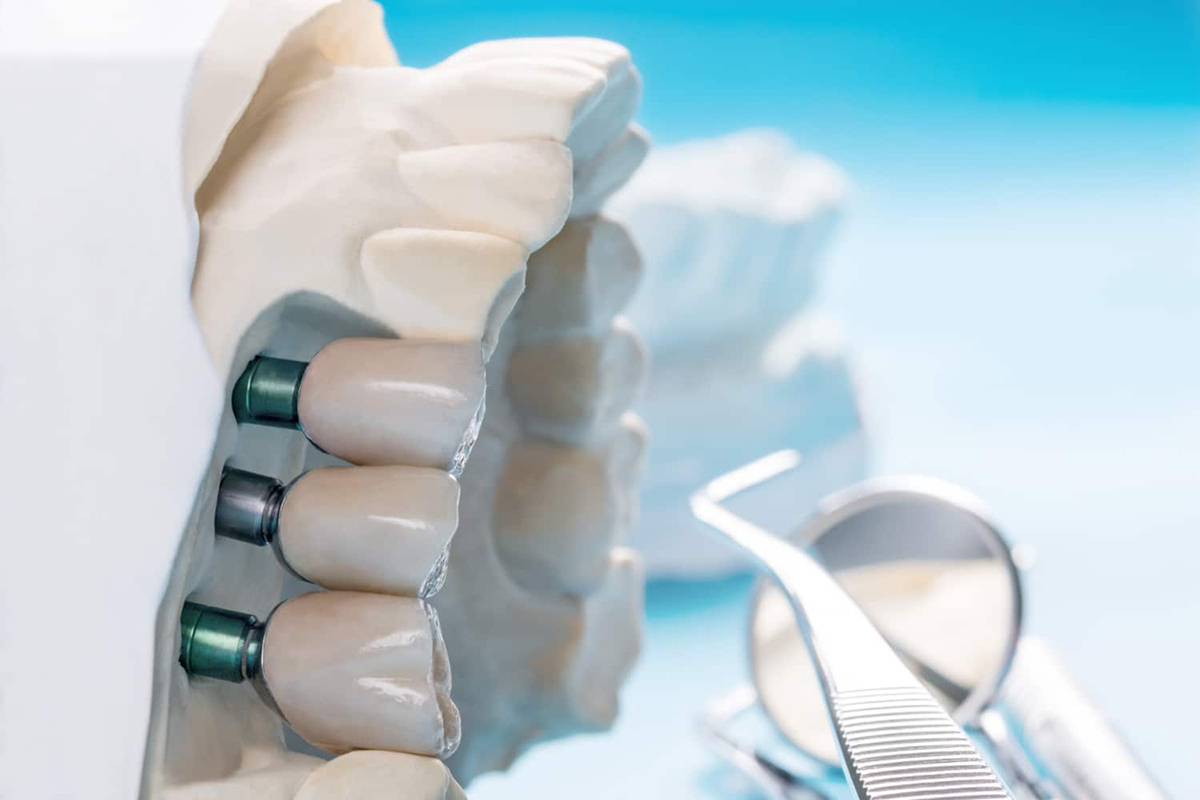Home>Finance>What Are Dental Implants Considered Under Insurance


Finance
What Are Dental Implants Considered Under Insurance
Modified: December 30, 2023
Discover if dental implants are covered by insurance and learn about the financial aspects of this popular tooth replacement option. Get insights on the cost, coverage, and financing options available.
(Many of the links in this article redirect to a specific reviewed product. Your purchase of these products through affiliate links helps to generate commission for LiveWell, at no extra cost. Learn more)
Table of Contents
- Introduction
- Understanding Dental Implants
- Dental Implants Coverage Under Insurance
- Types of Insurance Plans and Coverage for Dental Implants
- Pre-approval Process for Dental Implants
- Factors Affecting Insurance Coverage for Dental Implants
- Limitations and Exclusions in Dental Implant Insurance Coverage
- Tips for Maximizing Dental Implant Insurance Benefits
- Conclusion
Introduction
Welcome to the world of dental implants! Dental implants have revolutionized the field of dentistry, offering a long-term solution for individuals with missing teeth. Whether you have lost a tooth due to injury, decay, or other dental issues, dental implants provide a natural-looking and functional replacement that can enhance your smile and overall oral health.
However, one common concern for many individuals considering dental implants is the cost. Dental procedures can be expensive, and the thought of paying for dental implants out of pocket can be daunting. Fortunately, dental insurance can help alleviate some of the financial burden associated with dental implants.
In this article, we will delve into the world of dental implants and explore how insurance coverage can play a role in financing this transformative dental procedure. We will discuss the different types of insurance plans available, the pre-approval process for dental implants, factors that affect insurance coverage, and tips for maximizing your dental implant insurance benefits. So, let’s dive in and uncover the intricacies of dental implant coverage under insurance!
Understanding Dental Implants
Before we dive into the details of insurance coverage for dental implants, let’s first understand what dental implants are and how they work.
Dental implants are titanium posts that are surgically placed into the jawbone beneath the gum line. These posts act as anchors for replacement teeth, such as crowns, bridges, or dentures. The implants are designed to mimic the structure of a natural tooth root, providing stability, strength, and durability.
The process of dental implantation involves several steps. First, the implant post is placed into the jawbone to serve as the foundation for the artificial tooth. After the implant site heals, a connector, known as an abutment, is attached to the implant to hold the replacement tooth securely. Finally, the dentist or prosthodontist will fabricate a customized artificial tooth or teeth, which are then attached to the abutment.
One of the key advantages of dental implants is their ability to integrate with the jawbone through a process called osseointegration. This fusion between the implant and the bone provides a stable and reliable support system for the replacement tooth, ensuring long-term success.
In addition to their natural look and feel, dental implants offer numerous benefits. They improve speech and chewing ability, prevent bone loss in the jaw, and maintain the overall facial structure. Dental implants also eliminate the need for messy adhesives that are often required with traditional dentures.
It is important to note that dental implants are not suitable for everyone. Your dentist will evaluate your oral health, bone density, and overall medical history to determine if you are a good candidate for the procedure. They may also take x-rays, CT scans, or conduct other diagnostic tests to assess your suitability for dental implant surgery.
Now that we have a better understanding of dental implants, let’s move on to exploring how insurance coverage can help offset the cost of this transformative dental procedure.
Dental Implants Coverage Under Insurance
Insurance coverage for dental implants can vary significantly depending on the type of insurance plan you have. While some plans may provide comprehensive coverage for dental implants, others may have limitations or exclusions. It is crucial to review your insurance policy carefully to understand what is covered and what is not.
In general, dental insurance plans categorize dental procedures into three main categories: preventative, basic, and major. Preventative procedures, such as routine cleanings and exams, are typically covered at a higher percentage, often up to 100%, by insurance plans. Basic procedures, such as fillings and extractions, are typically covered at a lower percentage, usually around 70% to 80%. Major procedures, including dental implants, fall under this category and are subject to different coverage percentages.
For dental implants, insurance coverage may range from partial coverage to full coverage, depending on the insurance plan. Some insurance plans may cover a portion of the implant procedure, including the surgery and the abutment. However, the cost of the crown or the artificial tooth that is attached to the implant may not be fully covered or may not be covered at all.
It is important to note that dental implant coverage is often subject to annual maximums. These maximums represent the maximum amount that the insurance plan will pay in a given year. If the cost of the implant procedure exceeds the annual maximum, you may be responsible for the remaining balance.
Additionally, insurance plans may have waiting periods before they provide coverage for major procedures like dental implants. This means that you may need to be enrolled in the plan for a certain period of time before you are eligible for coverage for implant procedures. The waiting period can range from a few months to a year, depending on the insurance plan.
Understanding the coverage details of your insurance plan is crucial when considering dental implants. It is advisable to consult with your insurance provider and dentist to determine the level of coverage you can expect for the dental implant procedure.
Types of Insurance Plans and Coverage for Dental Implants
Insurance plans that cover dental implants fall into two main categories: dental insurance plans and medical insurance plans.
Dental insurance plans specifically cater to oral health needs and typically offer coverage for a wide range of dental procedures, including dental implants. These plans may have different levels of coverage, such as basic, comprehensive, or high-end coverage.
Under dental insurance plans, coverage for dental implants can vary. Some plans may cover a percentage of the implant procedure, while others may cover a specific dollar amount. It is essential to review the terms and limitations of your dental insurance plan to understand the extent of coverage for dental implants.
On the other hand, medical insurance plans may also provide coverage for dental implants, but the circumstances under which they provide coverage can be different. Medical insurance plans typically cover dental implant procedures that are deemed medically necessary, such as in cases of dental trauma or congenital abnormalities. To receive coverage under medical insurance, you may need to provide supporting documentation from your dentist or oral surgeon explaining the medical necessity of the dental implant procedure.
It is crucial to inquire with both your dental insurance provider and medical insurance provider to determine if dental implants are covered and under which plan. By understanding the coverage offered by each plan, you can maximize your benefits and minimize out-of-pocket expenses.
In some cases, individuals may have both dental insurance and medical insurance coverage, which can potentially increase the overall coverage for dental implant procedures. Coordinating benefits between both plans can help reduce the financial burden of dental implants.
It is important to note that not all insurance plans cover dental implants. Some plans may categorize dental implants as a cosmetic procedure and exclude coverage altogether. Therefore, it is crucial to carefully review the details of your insurance plan or consult with your insurance provider to determine if dental implant coverage is provided.
With the diverse range of insurance plans available, it is essential to research and choose a plan that aligns with your dental needs and provides suitable coverage for dental implants.
Pre-approval Process for Dental Implants
Before undergoing a dental implant procedure, it is advisable to go through the pre-approval process with your insurance provider. The pre-approval process involves submitting documentation and obtaining confirmation from your insurance company regarding the coverage for the dental implant procedure.
The pre-approval process typically starts with a consultation with your dentist or oral surgeon. During this consultation, your oral health will be assessed, and an individualized treatment plan will be created, including the dental implant procedure. Your dentist or oral surgeon will provide you with a detailed treatment plan, which includes the estimated costs of the implant procedure.
Once you have the treatment plan, you can submit it to your insurance provider for pre-approval. The insurance provider will review the treatment plan and determine the level of coverage for the dental implant procedure. This process may involve sending supporting documentation, such as x-rays, CT scans, or written explanations from your dentist or oral surgeon, highlighting the need for the dental implant procedure.
It is crucial to carefully review the details of the pre-approval response from your insurance provider. The response should outline the coverage and any out-of-pocket expenses you may be responsible for. If there are any discrepancies or concerns, it is essential to reach out to your insurance provider for clarification.
Obtaining pre-approval for dental implants can provide you with peace of mind, as you will have a clearer understanding of the coverage and potential expenses associated with the procedure. It also allows you to plan your finances accordingly and explore other options if necessary.
It is worth noting that the pre-approval process may take some time, so it is advisable to start this process well in advance of the scheduled dental implant procedure. This allows you to make informed decisions regarding your oral health and financial planning.
By going through the pre-approval process, you can have a better understanding of the financial aspect of the dental implant procedure and proceed with the treatment with confidence.
Factors Affecting Insurance Coverage for Dental Implants
Insurance coverage for dental implants can vary based on several factors. Understanding these factors can help you navigate through the insurance landscape and determine the extent of coverage for your dental implant procedure.
1. Insurance Plan Type: The type of insurance plan you have plays a significant role in determining the coverage for dental implants. Dental insurance plans and medical insurance plans may have different policies regarding dental implant coverage. It is crucial to review the terms and limitations of your specific insurance plan.
2. Plan Coverage Levels: Insurance plans often offer different coverage levels, such as basic or comprehensive coverage. The level of coverage directly impacts the percentage or dollar amount that the insurance company will pay for your dental implant procedure. Review your plan to understand the coverage level for major procedures like dental implants.
3. Pre-existing Conditions: Some insurance plans may have restrictions or limitations regarding pre-existing conditions. If you had missing teeth prior to obtaining the insurance plan, it is essential to review if dental implants for pre-existing conditions are covered. Coverage may vary depending on the insurance provider and plan.
4. Waiting Periods: Waiting periods are common with dental insurance plans. These waiting periods determine how long you must be enrolled in the plan before you become eligible for coverage on major procedures like dental implants. Waiting periods can range from a few months to a year or longer. Understanding the waiting period for your plan is crucial for planning your dental implant procedure.
5. Annual Maximums: Insurance plans often have annual maximums, which indicate the maximum amount the plan will pay for dental procedures in a given year. Dental implant procedures can be costly, so it is important to consider the annual maximum when determining the coverage and potential out-of-pocket expenses.
6. Medical Necessity: In some cases, dental implant procedures may be deemed medically necessary. Medical insurance plans may provide coverage for dental implants under these circumstances. Supporting documentation from your dentist or oral surgeon may be required to demonstrate the medical necessity of the procedure.
7. In-network vs. Out-of-network Providers: Some insurance plans have preferred networks of providers. If your dentist or oral surgeon is in-network with your insurance plan, it may result in higher coverage for dental implant procedures. Review your plan to understand the impact of in-network and out-of-network providers on coverage.
It is vital to note that each insurance plan is unique, and the factors affecting coverage can vary. Carefully review your insurance policy, consult with your insurance provider, and discuss with your dentist or oral surgeon to fully understand the factors that may impact the coverage for your dental implant procedure.
Limitations and Exclusions in Dental Implant Insurance Coverage
While dental insurance can provide coverage for dental implant procedures, it is important to be aware of the limitations and exclusions that may apply. Understanding these limitations and exclusions will help you manage your expectations and plan for any potential out-of-pocket expenses.
1. Missing Teeth Clause: Some dental insurance plans have a missing teeth clause, which means they do not provide coverage for dental implant procedures if the tooth loss occurred prior to obtaining the insurance coverage. This clause is commonly seen in plans with waiting periods, typically ranging from six months to a year. Carefully review your plan to understand if this limitation applies.
2. Cosmetic Dentistry Exclusions: Dental insurance plans often categorize dental implant procedures as cosmetic dentistry. Unfortunately, many plans exclude or provide limited coverage for cosmetic procedures. If your plan specifically excludes cosmetic dentistry, it is likely that the coverage for dental implants will be affected.
3. Coverage Percentage and Maximums: Dental insurance plans typically cover dental implant procedures at a percentage, such as 50% or 70%. This means that you will be responsible for paying the remaining percentage out of pocket. Additionally, plans often have annual maximums, which are the maximum amounts the plan will pay for dental procedures in a given year. If the cost of the implant procedure exceeds the annual maximum, you may have to cover the remaining balance.
4. Waiting Periods: As mentioned earlier, dental insurance plans may have waiting periods before coverage for major procedures, including dental implants, begins. This means that you may need to be enrolled in the plan for a specified period of time before you can access coverage for the implant procedure. Waiting periods can vary between plans, so it is important to review your specific plan’s waiting period policy.
5. Alternative Treatment Options: Insurance plans may have limitations on the type of dental implant procedure they cover. They may only cover the most basic form of dental implant, while excluding more advanced or specialized techniques. If you opt for a more advanced procedure, you may need to cover the additional costs out of pocket.
It is important to carefully review your insurance plan’s coverage details, limitations, and exclusions related to dental implant procedures. This will help you understand the level of coverage you can expect, any potential out-of-pocket expenses, and whether alternative treatment options are covered.
If your dental insurance plan does not provide adequate coverage for dental implants, consider exploring other options, such as supplemental dental insurance plans or dental discount plans, which may provide additional coverage or discounts to help offset the cost of dental implant procedures.
Tips for Maximizing Dental Implant Insurance Benefits
When it comes to maximizing your dental implant insurance benefits, there are several tips and strategies you can employ. These tips can help you make the most out of your coverage and minimize out-of-pocket expenses. Here are some helpful tips to consider:
1. Review Your Insurance Policy: Start by thoroughly reviewing your dental insurance policy to understand the specific coverage details for dental implant procedures. Familiarize yourself with the coverage percentage, annual maximums, waiting periods, and any limitations or exclusions that may apply.
2. Choose In-network Providers: Opting for a dentist or oral surgeon who is in-network with your insurance plan can help maximize your benefits and reduce overall costs. In-network providers often have negotiated rates with insurance companies, resulting in lower out-of-pocket expenses for you.
3. Coordinate Benefits: If you have both dental and medical insurance coverage, coordinate benefits between the two plans. Some dental implant procedures may be considered medically necessary, which could be covered by your medical insurance plan. Coordinating benefits can help maximize coverage and reduce your financial burden.
4. Consider Supplemental Insurance: Explore the option of supplemental dental insurance plans. These plans are designed to provide additional coverage for dental procedures not covered by your primary dental insurance. Supplemental plans may offer higher percentages of coverage or higher annual maximums specifically for major procedures like dental implants.
5. Optimize Timing: If you have the flexibility to plan your dental implant procedure, strategically time it to maximize your insurance benefits. For example, if you have reached your annual maximum, it may be beneficial to schedule the procedure in the following year to take advantage of a fresh annual maximum.
6. Utilize Flexible Spending Accounts (FSAs) or Health Savings Accounts (HSAs): If you have an FSA or HSA, consider utilizing it to fund your dental implant procedure. These accounts allow you to set aside pre-tax dollars for eligible medical expenses, including dental treatments. Using these accounts can provide tax savings and help you manage the cost of the procedure.
7. Negotiate Payment Plans: If your insurance coverage falls short and you are facing significant out-of-pocket expenses, discuss payment plans or financing options with your dental provider. Many dental offices offer flexible payment plans to help make the cost more manageable over time.
8. Maintain Good Oral Health: Taking care of your oral health can help prevent the need for extensive dental procedures, including dental implants. Regular brushing, flossing, and dental check-ups can help maintain your natural teeth and reduce the likelihood of tooth loss, ultimately reducing the need for costly dental implant procedures.
Remember, every insurance plan is different, and it is important to understand your specific coverage and benefits. Consult with your dental insurance provider, ask questions, and work closely with your dental provider to navigate the insurance process and maximize the benefits for your dental implant procedure.
Conclusion
Dental implants are an excellent solution for individuals with missing teeth, offering a natural-looking and long-lasting replacement option. While the cost of dental implants can be a concern, understanding the coverage provided by dental insurance plans can help alleviate financial burdens.
In this article, we have explored various aspects of dental implant insurance coverage. We discussed the importance of understanding dental implants, the coverage provided by insurance plans, the pre-approval process, and factors that can affect coverage. We also highlighted the limitations and exclusions that may apply and provided tips for maximizing dental implant insurance benefits.
It is crucial to carefully review your dental insurance policy, consult with your insurance provider, and collaborate with your dental provider to gain a comprehensive understanding of your coverage. This knowledge will help you plan your dental implant procedure effectively and make informed decisions regarding your oral health and financial aspects.
Remember, every insurance plan is different, and the coverage for dental implant procedures can vary significantly. It is essential to be proactive, ask questions, and explore alternative options if necessary to ensure you receive the maximum benefits from your insurance coverage.
By understanding the ins and outs of dental implant insurance coverage, you can embark on your journey towards a healthier and more confident smile. Dental implants offer a life-changing solution, and with the right insurance coverage, they can be made more accessible and affordable.
If you have questions or concerns about dental implant insurance, do not hesitate to reach out to your insurance provider or dental professional. They will guide you through the process and help you make informed decisions regarding your dental health and insurance coverage.














